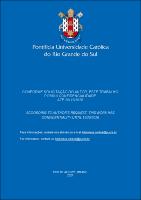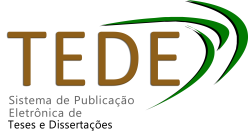| Share record |


|
Please use this identifier to cite or link to this item:
https://tede2.pucrs.br/tede2/handle/tede/10023Full metadata record
| DC Field | Value | Language |
|---|---|---|
| dc.creator | Dall'Azen, Gabriel Castro | - |
| dc.creator.Lattes | http://lattes.cnpq.br/0613683185950094 | por |
| dc.contributor.advisor1 | Rockenbach, Maria Ivete Bolza | - |
| dc.contributor.advisor1Lattes | http://lattes.cnpq.br/2029320684832568 | por |
| dc.date.accessioned | 2021-12-20T17:43:28Z | - |
| dc.date.issued | 2020-03-05 | - |
| dc.identifier.uri | http://tede2.pucrs.br/tede2/handle/tede/10023 | - |
| dc.description.resumo | Este estudo teve como objetivo identificar e analisar o trajeto do canal mandibular e incisivo em seu percurso desde a entrada na mandíbula pelo forame mandibular até a saída pelo forame mentual e, se dirigindo para a linha média mandibular, em sua continuidade como canal incisivo. Foram utilizados exames de tomografia computadorizada de feixe cônico (TCFC) de 144 pacientes, sendo 50 homens e 94 mulheres, pertencentes ao banco de dados do Curso de Odontologia da Escola de Ciências da Saúde e da Vida da PUCRS. Caracteriza-se como um estudo observacional retrospectivo com uma análise quantitativa e comparativa dos pontos de referência mandibulares visualizados em exames tomográficos e analisados com o software On-Demand. No trajeto do canal mandibular (CM) e do canal incisivo (CI) foram delimitados cortes transversais, perpendiculares à base da mandíbula, e realizadas medidas do CM e do CI, a partir dos ápices dos elementos dentários e em relação às corticais mandibulares. No presente estudo foram feitas comparações das medidas e localização dos canais, entre os lados direito e esquerdo da mandíbula, e entre os sexos masculino e feminino. As mulheres apresentaram maior proximidade do canal mandibular aos ápices dentários e menores distâncias do canal mandibular à cortical vestibular. Os homens apresentaram as menores distâncias do canal mandibular à cortical lingual e maior diâmetro do canal mandibular. Tanto para homens quanto para mulheres, o canal mandibular apareceu mais próximo da base mandibular na região do segundo molar. Na comparação entre os sexos, um número considerável de medidas apresentou diferença significativa nas distâncias analisadas, diferente do que ocorreu quando foram comparados os lados direito e esquerdo da mandíbula. | por |
| dc.description.abstract | This study aimed to identify and analyze the path of the mandibular canal from its entrance in the mandible through the mandibular foramen to its exit through the mental foramen, then going to the mandibular middle line as incisive canal. Cone beam computed tomography (CBCT) from 144 patients were used (50 men and 94 women), which belong to the database of the Dentistry Dental School PUC-RS. It’s a retrospective and observational study with comparative and quantitative analysis of the mandibular reference points viewed on tomographic exams and analysed with On-Demand™ software. In the path of the mandibular canal (MC) and incisive canal (IC) some transversal cuts were made, perpendicular to the mandibular base, and the distance between the dental apices and mandibular cortical were measured in both MC and IC. Comparisons regarding the distances and locations of the canals were made, comparing left and right sides, female and male patients. Women showed bigger proximity between the mandibular canal to dental apices and a smaller distance between the mandibular canal to the mandibular cortical. Men showed smaller distances from the mandibular canal to the lingual cortical as well as a mandibular canal with bigger diameter. Mandibular canal seemed to be closer to the mandibular base in lower second molar region for both men and women. When comparing genders, a considerable amount of measures showed significant difference on the distances analyzed, which didn’t happen when right and left sides of the mandible were compared. | eng |
| dc.description.provenance | Submitted by PPG Odontologia ([email protected]) on 2021-12-16T15:02:54Z No. of bitstreams: 1 GABRIEL_CASTRO_DALL’AZEN_DIS.pdf: 1840193 bytes, checksum: 5206a003e533eec2caf01cfd0ea7a611 (MD5) | eng |
| dc.description.provenance | Approved for entry into archive by Sheila Dias ([email protected]) on 2021-12-20T17:39:34Z (GMT) No. of bitstreams: 1 GABRIEL_CASTRO_DALL’AZEN_DIS.pdf: 1840193 bytes, checksum: 5206a003e533eec2caf01cfd0ea7a611 (MD5) | eng |
| dc.description.provenance | Made available in DSpace on 2021-12-20T17:43:28Z (GMT). No. of bitstreams: 1 GABRIEL_CASTRO_DALL’AZEN_DIS.pdf: 1840193 bytes, checksum: 5206a003e533eec2caf01cfd0ea7a611 (MD5) Previous issue date: 2020-03-05 | eng |
| dc.description.sponsorship | Conselho Nacional de Pesquisa e Desenvolvimento Científico e Tecnológico - CNPq | por |
| dc.description.sponsorship | Coordenação de Aperfeiçoamento de Pessoal de Nível Superior - CAPES | por |
| dc.format | application/pdf | * |
| dc.thumbnail.url | http://tede2.pucrs.br:80/tede2/retrieve/182925/DIS_GABRIEL_CASTRO_DALL%e2%80%99AZEN_CONFIDENCIAL.pdf.jpg | * |
| dc.language | por | por |
| dc.publisher | Pontifícia Universidade Católica do Rio Grande do Sul | por |
| dc.publisher.department | Escola de Ciências Saúde e da Vida | por |
| dc.publisher.country | Brasil | por |
| dc.publisher.initials | PUCRS | por |
| dc.publisher.program | Programa de Pós-Graduação em Odontologia | por |
| dc.rights | Acesso Aberto | por |
| dc.subject | Tomografia Computadorizada de Feixe Cônico | por |
| dc.subject | Mandíbula | por |
| dc.subject | Ápice Dentário | por |
| dc.subject.cnpq | CIENCIAS DA SAUDE::ODONTOLOGIA | por |
| dc.title | Estudo anatômico dos canais mandibular e incisivo com uso de tomografia computadorizada de feixe cônico | por |
| dc.type | Dissertação | por |
| dc.restricao.situacao | Trabalho será publicado como artigo ou livro | por |
| dc.restricao.prazo | 60 meses | por |
| dc.restricao.dataliberacao | 20/12/2026 | por |
| Appears in Collections: | Programa de Pós-Graduação em Odontologia | |
Files in This Item:
| File | Description | Size | Format | |
|---|---|---|---|---|
| DIS_GABRIEL_CASTRO_DALL’AZEN_CONFIDENCIAL.pdf | GABRIEL_CASTRO_DALL'AZEN_DIS | 357.42 kB | Adobe PDF |  Download/Open Preview |
Items in DSpace are protected by copyright, with all rights reserved, unless otherwise indicated.




